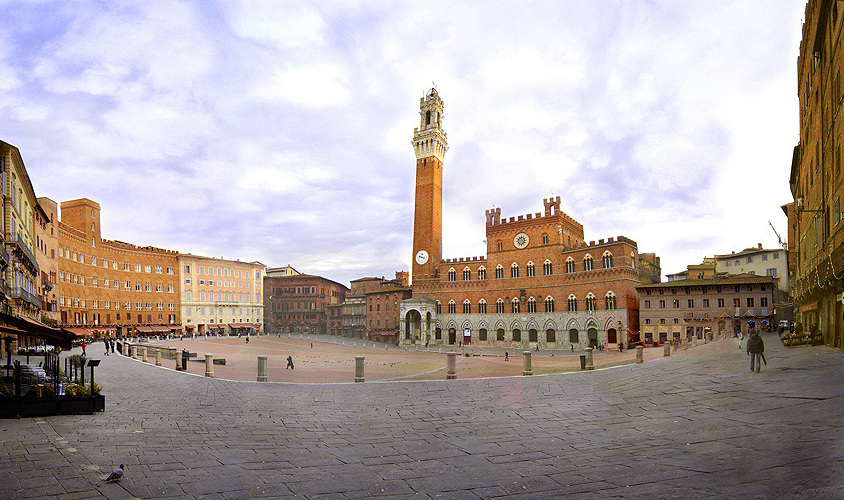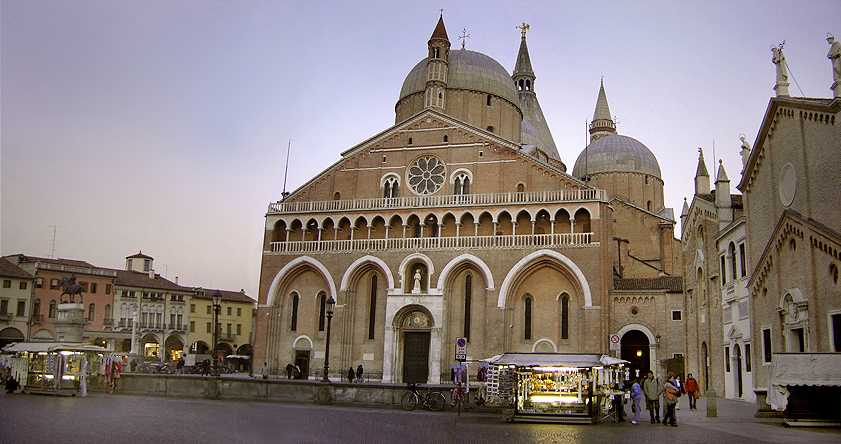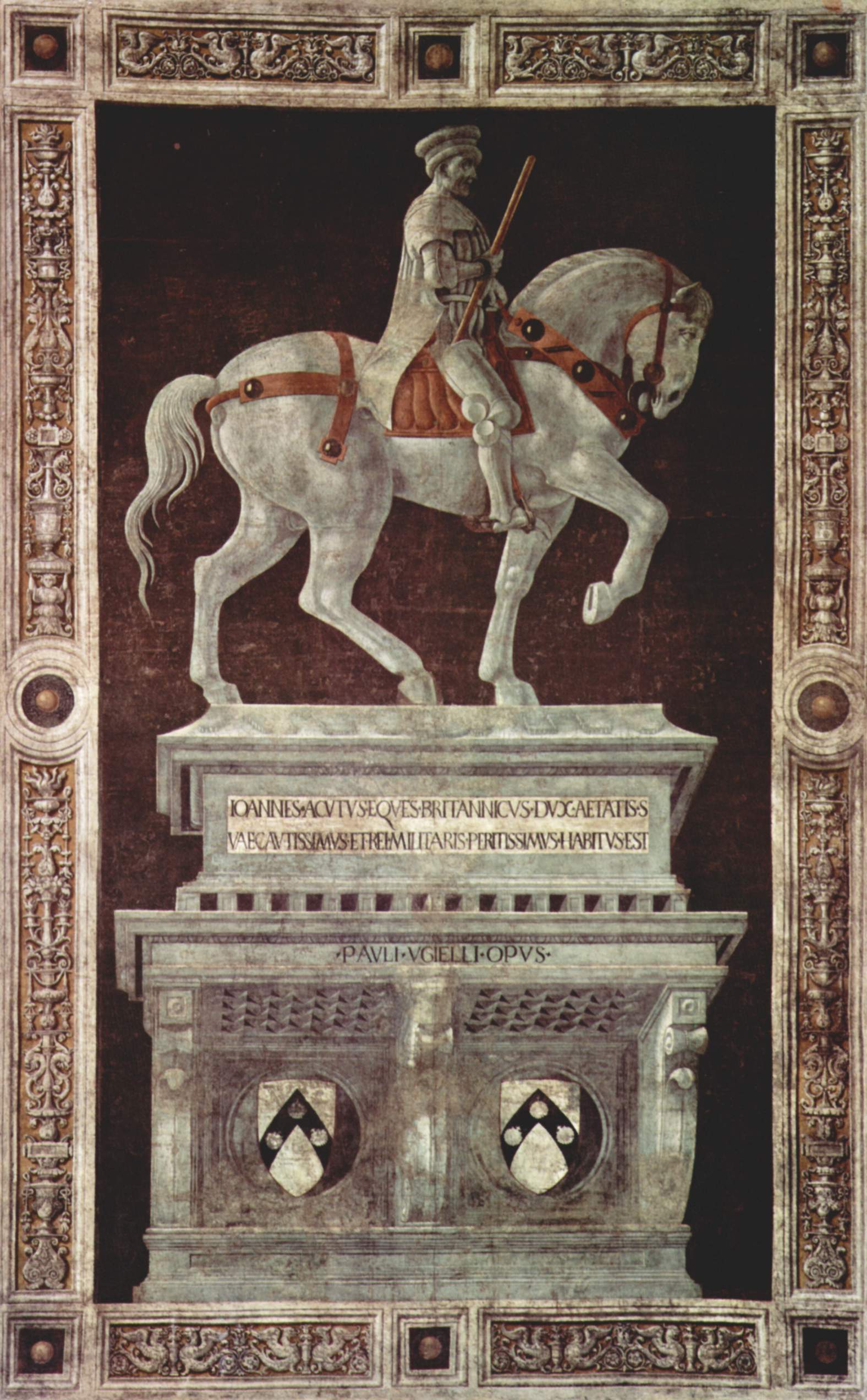 |
| Siena |
The schism
between Rome and Avignon[i] caused mayhem in Italy,
never the most stable of regions. Many of the grand seigneurs of Italy used the
problems as a smokescreen to continue old feuds. In 1384 Hawkwood presided over
the successful eradication of the Sienese citizen army, by a conglomeration of
a number of companies, including contingents of Bretons, Italians and English.
The Company of the Rose, with Florentine backing, proceeded to drain Siena’s
wealth.
Now Hawkwood
was captain-general of Florence, captain of the Company of the Rose,
gonfaloniere of the church, Duke of Spoleto[ii] and the ambassador of the
King of England. In October 1383 Hawkwood purchased a rural estate outside
Siena for six thousand florins. In 1384 he obtained possession of Montecchio,
near Cortona. He also owned the castles of Montefortino in Ancona and Abbazia a
Pino in Val dAmbra, along with a string of other properties.
But the
family lived at the San Donato property outside Florence. Donnina proved to be
a capable businesswoman and managed Hawkwood’s affairs. Despite the falling out
between her husband and her father Donnina had kept her dowry properties in
Lombardy.
Coronation of Gian Galeazzo Visconti
Bernabo was
now 76 and in conflict with his nephew Gian Galeazzo Visconti. On 5th May 1385 Gian
Galeazzo overthrew his uncle, making himself Count of Milan[iii]. Hawkwood appears to
have pledged his loyalty to his wife’s cousin for a thousand florins; he had
already ignored a plea from one of his wife’s brothers. On 1st July
a contract was drawn up, at Modena, agreeing
‘That if the Count should
request his personal service, he would hold himself obliged to go to him.’[iv]
This would only
apply if Hawkwood was not bound by other contracts and he was to be paid three
hundred florins a month. Gian Galeazzo had already seized Donnina’s properties
and the contract could hardly be considered favourable to Hawkwood, who could
command much higher terms. He never honoured the contract.
Working in Old Age
Padua
A period of
relative quiet in central Italy was not to the liking of someone of Hawkwood’s
temperament and in 1386 Hawkwood was happy to be employed by Padua in a fight
that erupted between its Lord and Verona. He was now an old man of circa 65,
but was not content to rest quietly on his laurels.
His large
army was caught in a trap and the lines of communication and provisioning were
cut. The troops were forced to feed on turnips and their own horses. But
according to legend help was at hand;
‘He [Hawkwood] produced the
horn of a unicorn (according to one chronicler, it was five feet long), which
he dipped into the contaminated wells. The result of this magical procedure was
the purification of the water.’[v]
Hawkwood’s
men retreated and made a stand at Castagnaro where, greatly outnumbered, they
defeated the Veronese army on 11th March 1387. Two days later
Hawkwood returned in triumph to Padua
‘There was a great feasting
of the people……….a great supper at Court, fires of joy and martial music all
night.’[vi]
He returned
to Florence to apply to the Commune for permission to sell his properties to
pay off his debts. They granted him monies payable to Donnina, for one year.
Mercenary companies do not come cheap, and a lot of the fees Hawkwood received
would have been used to pay for his men and their equipment. Some of his
problems appear to have arisen from his choice of bankers, one of whom failed
to pay his creditors[vii].
In May 1388
Hawkwood finally became the father of a son, named John after his father.
The Last Campaign
Gian Galeazzo Visconti
Gian
Galeazzo had long been preparing his coup in Milan and almost immediately instituted
legal, agricultural, industrial and commercial reforms. He also commenced
military reforms; taking into his employment condottiere who agreed to work for
set periods of up to ten years. He thus created a standing army for Milan.
Siena, Pisa and Perugia were quick to ally with this military star.
Florence
initiated the anti-Visconti league with Bologna, Padua and Verona (uniting
against a greater common enemy). Their captain general meanwhile was working in
the south, where the continuing problems in Naples provided much work for
mercenary troops. On 3rd May 1390 Hawkwood was re-engaged as
Florentine captain-general for the term of one year.
Hawkwood
marched north and managed to reverse several recent Visconti gains; Bologna was
secured and then Parma and Ferrara deserted the Visconti and joined the league.
By January 1391 the league’s armies were encamped outside Padua; they were led
by
‘Signor Giovanni Aucud – who
is so celebrated for the remembrance of his worthy achievements, and with this
victory is about to give the last and greatest elevation to his fame.’[viii]
Sadly the
weather and the behaviour of the locals doomed the affair and the offensive
stalled.
By May the
campaign started anew and Hawkwood was pressed into retreating. One night the
army camped by the river Adige, which flooded overnight sweeping away many of
the soldiers. Gian Galeazzo Visconti recorded the
‘Swift and precipitous fight
of Signor Giovanni Acuto, and of the forces of the League from my territory,
which was of such a kind, and brought about such a massacre of people and
horses, and such a loss of baggage, that it might more fitly be termed a rout
than a retreat.’[ix]
In September
Hawkwood’s men captured a Visconti standard that was ‘ripped to shreds’ by the
citizens of Florence. Gian Galeazzo decided that the only option at the present
was to agree to a general peace, which was concluded at Genoa and solemnised in
Florence on 18th February 1391. In gratitude for Hawkwood’s labours
on their behalf Florence granted him immunity from forced loans.[x]
Insolvency
Duomo, Florence
In April
Florence more than doubled Hawkwood’s pension to 3,000 gold florins per annum
and his daughters were now given a dowry of 2,000 gold florins each. After his
death Donnina was to receive a pension of 1,000 florins. The family and their
descendants were given Florentine citizenship into the bargain.
On 19th
November 1392 Florence paid Janet’s dowry, two months after her marriage to Brezaglia
di Porciglia, son of a count of Fruili. On 21st January 1393
Hawkwood’s second daughter Catherine was wed to Conrad Prosbergh; a German
mercenary in the employ of Florence. Despite appearances the family was
penniless and Conrad had to beg for money for Catherine’s wedding dress asking
‘That I may have 1,000
florins which are owing of my pension…….that Madonna Donnina may dress my wife
for the wedding………..Madonna Donnina writes that nothing is wanting except the
money to dress her.’[xi]
On 11th
July 1393 Hawkwood wrote to the Commune of Florence informing them that he
could not pay the 1,834 florins he owed, as his annuity of 2,000 florins from
the Commune had not been paid to him. He had jewellery pledged in Venice and
Bologna but could not afford to redeem them. It was now necessary for him to
sell his property.
On 12th
March 1394 Hawkwood surrendered all his rights to a pension, his wife’s rights
and Anna’s right to a dowry for 6,000 gold florins from the Commune.
‘Hawkwood, weary by reason
of his great age, and as he asserts, weighed down by infirmity, wishes to
return to his old country.’[xii]
Apparently
this had been in his mind for some time and Hawkwood had been channelling money
back to England. He was in contact with his eldest daughter’s relatives by
marriage, sending his squire John Sampson with a letter of introduction. In
April 1393 an agreement was signed between Thomas Coggeshall[xiii] and Sampson
‘And also my mayster sendeth
you to seyen that yif he deye before his coming hom that ye wolde knowe his
will what he wolde were don with the landes and tenementz that hath been
purchased to his bihufthe in Englond.’[xiv]
Not only his
financial but also spiritual desires were made known in the agreement; which is
the only indication of how Hawkwood planned to dispose of his possessions; he
never made a will. His family were apparently safeguarded; but Hawkwood was
never to make the journey home.
Death of a Mercenary
Credited by
the Florentines for their rescue from the expansionist plans of the Visconti
family; Sir John Hawkwood died in his bed, on 18th March 1394, aged
around 74 years, a prodigious age for not only the times but a man of his
profession. Florence spent 410 gold florins, 1 lira and 11 soldi on the
magnificent funeral of their captain-general, who was buried in the Duomo.
‘And so the man who had
lived in victory was given in death the greatest glory.’[xv]
After his
death the Florentines planned a magnificent monument to their condottiere; but
cost reduced the scale of the memorial and a mural by Paolo Uccello was painted on the wall of the Duomo. Hawkwood’s monument in
Florence cathedral was a far cry from his comparatively humble roots in Essex.
On 29th
March 1395 the Signoria wrote a letter of introduction to Richard II on behalf
of Donnina. His reply was swift; Richard II requested the return of Hawkwood’s
body to his native land, and reluctantly the Signoria consented
There is no
evidence that Donnina made the journey to England but early in 1398 she
petitioned Richard requesting an investigation into the alleged embezzlement of
her husband’s investments. On 24th February 1398 Richard Whittington, Lord Mayor of London was instructed by the king’s
council to appoint a jury to investigate Donnina’s complaint.
Witnesses
were bought to attest before the court which found that Hawkwood had purchased
‘A tenement called
Ledenhalle, in the parish of St Peter with a part of the money, viz. the sum of
1200 marks, to the use of John Hawkwood………..The jurors were unable to resolve
what had happened to the deeds of the property, or indeed the chest belonging
to Hawkwood which had been placed in St Paul’s church for safe custody.’
By January
1399 Donnina was living in Milan with her son John. Anna had by this time
married a member of an influential Milan family, the della Torres. In 1406 the
young John Hawkwood travelled to England and was naturalised later that year.
He took over the administration of the estates purchased by his father in and
around his home village of Sible Hedingham, where he was still living in 1464.
John married a woman named Margaret, the couple had no children
Bibliography
Italian
Dynasties – Edward Burman, Thorsons Publishing 1989
The
Fourteenth Century – May McKisack, Oxford University Press 1997
A History of
Venice – John Julius Norwich, Penguin Books 1982
Hawkwood –
Frances Stonor Saunders, Faber & Faber Ltd 2004
A Distant
Mirror – Barbara Tuchman, Pan MacMillan Publishers Ltd 1989
www.wikipedia.en
[i] From 1378 to 1417
[ii]
A papal bestowal
[iii]
It is believed that Gian Galeazzo had Bernabo poisoned in prison
[iv]
Hawkwood – Stonor Saunders
[v]
Ibid
[vi]
Ibid
[vii]
Hawkwood had deposited 7,300 florins with Alderigo Antelminelli
[viii]
Hawkwood – Stonor Saunders
[ix]
Ibid
[x]
Used to fund dealing with crises
[xi]
Hawkwood – Stonor Saunders
[xii]
Ibid
[xiii]
William Coggeshall’s uncle
[xiv]
Hawkwood – Stonor Saunders
[xv]
Ibid




2000 florins is a FORTUNE... a florin is about 4/8d - 5/- [depending on the rate of exchange which fluctuated slightly] so around £500, which would have the buying power of close on £1million now, if I have calculated that correctly... I'm more familiar with the monetary exchange 100 years later
ReplyDelete